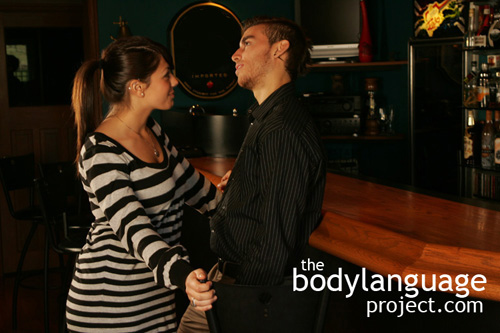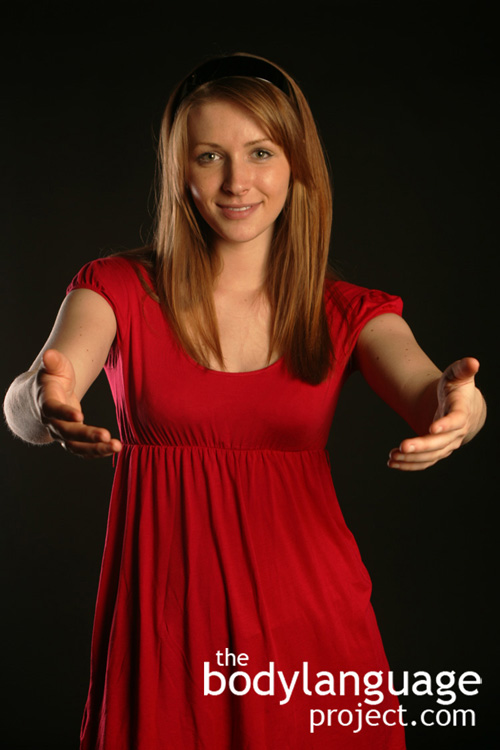Body Language of Feet Wrapped Around Legs Of Chair
 Cue: Feet Wrapped Around Legs Of Chair
Cue: Feet Wrapped Around Legs Of Chair
Synonym(s): Ankles Wrapped Around Legs Of Chair, Legs Clamped Around Chair, Wrapping The Legs Around The Feet Of A Chair.
Description: The ankles are wrapped around the feet of a chair as if shackled in place.
In One Sentence: Wrapping the feet around the legs of a chair signals the desire to be locked in place and feel safe and secure.
How To Use it: Wrap the legs around the chair when you want to create the sense of security for which you currently lack. Anchoring to your surroundings can help ground you and by extension your mind. That being said, the cue indicates lack of confidence, so should generally be avoided.
Context: General.
Verbal Translation: “I’m stressed and uncomfortable and I’m bracing myself for a bad outcome from which I can not escape. I’m wrapping my feet, clenching my hands against the arms rests, and trying to secure myself from being tossed.”
Variant: We habitually see this self arresting, gripping when people ride in the passenger side of a car with a bad or aggressive driver. People will hold their seat belt, the upper hand grip on the ceiling of the car or the grips in the door. We also see this in amusement park roller coaster rides where people hold their restraints.
Cue In Action: During a high intensity inquisition, he wrapped his feet around the legs of the chair.
Meaning and/or Motivation: It says, “I’m not going anywhere, not doing anything and not cooperating.” This posture is a freeze response and is normal during high stress, discomfort and concern, especially when exiting is not possible. Locking into a chair gives us a protective feeling as we try to prevent ourselves from being figuratively tossed around.
We see this when people are fastened into roller coasters where people will hug the restraints for extra safety.
When the hands grip the armrest coupled with ankles locked around the legs of the chair, not only does it give us comfort, but it provides a tactile release. It gives our hands something to do, thus preventing them from gesticulating. This is yet another way we nonverbally express our desire to keep quiet, as gesticulating could give up information we wish not to divulge.
Cue Cluster: Usually the head is pulled back or turned away, chin up, body leaning deep into the seat, eyes are forward, face is blank, lips pursed, the lip or inside of the cheek may be bitten, teeth clenched, knuckles turning white from gripping the arm rest and blanching of the skin.
Body Language Category: Anger, Clenching and gripping, Dislike (nonverbal), Escape movements, Frustrated body language, Hostile body language, Masked emotions, Pacifying, Stubborn or stubbornness.
Resources:
Arduino, P. J., & Gould, J. L. (1984). Is tonic immobility adaptive? Animal Behavior, 32, 921–923.
Bracha, H. S. (2004). Freeze, flight, fight, fright, faint: Adaptionist perspectives on the acute stress response spectrum. CNS Spectrums, 9, 679–685.
Burgess, A. W., & Holmstrom, L. L. (1976). Coping behavior of the rape victim. American Journal of Psychiatry, 133, 413–418.
Cannon, W. B. (1929). Bodily changes in pain, hunger, fear and rage (2nd ed.). New York: Appleton, Century, Crofts.
Estes, Zachary Estes and Michelle Verges. Freeze or flee? Negative stimuli elicit selective responding. Cognition. 2008. 108(2): 557-565.
Fyer, M. R., Uy, J., Martinez, J., & Goetz, R. (1987). CO2 challenge of patients with panic disorder. American Journal of Psychiatry, 144, 1080–1082.
Friedman, Ron and Andrew J. Elliot. The Effect Of Arm Crossing On Persistence And Performance. European Journal of Social Psychology. 2008; 38, 449–461 (2008).
Galliano, G., Noble, L. M., Travis, L. A., & Puechl, C. (1993). Victim reactions during rape/sexual assault: A preliminary study of the immobility response and its correlates. Journal of Interpersonal Violence, 8, 109–114.
Gallup, G. G. (1977). Tonic immobility: The role of fear and predation. Psychological Record, 27, 41–61.
Gillis, M. M., Haaga, D. A., & Ford, G. T. (1995). Normative values for the beck anxiety inventory, fear questionnaire, Penn state worry questionnaire, and social phobia and anxiety inventory. Psychological
Assessment, 7, 450–455.
Harmon-Jones, Eddie and Carly K. Peterson. Supine Body Position Reduces Neural Response to Anger. Association for Psychological Science. 2009; 20 (10): 1209-1210.
Heidt, J. M., Marx, B. P., & Forsyth, J. P. (2005). Tonic immobility and childhood sexual abuse: A preliminary report evaluating the sequela of rape-induced paralysis. Behavior Research and Therapy, 43, 1157–1171.
Hung, Iris W. and Aparna A. Labroo. From Firm Muscles to Firm Willpower: Understanding the Role of Embodied Cognition in Self-Regulation. Journal of Consumer Research, Vol. 37, No. 6 (April 2011), pp. 1046-1064. Article DOI: 10.1086/657240
http://bodylanguageproject.com/articles/10-simple-body-postures-tricks-boost-brain-power/
IJzerman, Hans; Marcello Gallucci C; Wim T.J.L.; Pouw, Sophia C.; Weigerber, Niels J.; Van Doesum; and Kipling D. William. Cold-Blooded Loneliness: Social Exclusion Leads To Lower Skin Temperatures. Acta Psychologica. 2012; 140: 283-288.
IJzerman, Hans and Gün R. Semin. Temperature Perceptions As A Ground For Social Proximity. Journal Of Experimental Social Psychology. 2010; 46: 867-873.
Johnson, Bret K. ; Kenkel, Mary Beth. Stress, coping, and adjustment in female adolescent incest victims. Child Abuse & Neglect. 1991. 15(3): 293-305.
Kalin, N. H., Shelton, S. E., Rickman, M., & Davidson, R. J. (1998). Individual differences in freezing and
cortisol in infant and mother rhesus monkeys. Behavioral Neuroscience, 112, 251–254.
Karin Roelofs; Muriel A. Hagenaars; and John Stins. Facing Freeze: Social Threat Induces Bodily Freeze in Humans. Psychological Science. 2010 21(11): 1575-1581.
http://bodylanguageproject.com/articles/angry-faces-elicit-freeze-response-in-people-research/
Lakoff, George and Mark Johnson. Metaphores we live by. University of Chicago Press. 2008.
Li Huang, Adam D. Galinsky, Deborah H Gruenfeld and Lucia E. Guillory. Powerful Postures Versus Powerful Roles: Which Is the Proximate Correlate of Thought and Behavior? 2011, Psychological Science; 22(1): 95–102.
Liebowitz, M. R., Gorman, J. M., Fyer, A. J., Dillon, D. J., & Klein, D. F. (1984). Effects of naltrexone on patients with panic attacks. American Journal of Psychiatry, 141, 995–997.
Lynden K. Miles, Louise K. Nind, and C. Neil Macrae. Moving Through Time. Psychological Science. 2010; 21(2): 222-223.
Mattick, R. P., & Clarke, J. C. (1998). Development and validation of measures of social phobia scrutiny fear and social interaction anxiety. Behaviour Research and Therapy, 36, 455–470.
Navarro, Joe. 2008. What Every BODY is Saying: An Ex-FBI Agent’s Guide to Speed-Reading People. William Morrow Paperbacks.
Pease, Barbara and Allan Pease. 2006. The Definitive Book of Body Language Hardcover. Bantam.
Parzuchowski, Michal and Bogdan Wojciszke. Hand Over Heart Primes Moral Judgments and Behavior. Journal of Nonverbal Behavior, 2014; 38:145–165.
Parzuchowski, Michal, Szymkow-Sudziarsky, A., Baryla, W., Wojciszke, B. (in press). From the Heart: Hand over Heart as an Embodiment of Honesty. Cognitive Processing. doi: 10.1007/s10339-014-0606-4.
Pitterman, Hallee ; Nowicki Jr, Stephen. A Test of the Ability to Identify Emotion in Human Standing and Sitting Postures: The Diagnostic Analysis of Nonverbal Accuracy-2 Posture Test (DANVA2-POS). Genetic, Social, and General Psychology Monographs. 2004. 130(2): 146-162.
Reiss, S., Peterson, R. A., Gursky, D. M., &McNally, R. J. (1986). Anxiety sensitivity, anxiety frequency, and the prediction of fearfulness. Behaviour Research and Therapy, 24, 1–8.
Sagliano, Laura ; Cappuccio, Angela ; Trojano, Luigi ; Conson, Massimiliano. Approaching threats elicit a freeze-like response in humans. Neuroscience Letters. 2014. 561: 35-40.
Schmidt, Norman B. ; Richey, J. Anthony ; Zvolensky, Michael J. ; Maner, Jon K. Exploring human freeze responses to a threat stressor. Journal of Behavior Therapy and Experimental Psychiatry. 2008. 39(3): 292-304.
Schmidt, N. B., & Joiner, T., Jr. (2002). Structure of the anxiety sensitivity index: Psychometrics and factor structure in a community sample. Journal of Anxiety Disorders, 16, 33–49.
Schmidt, N. B., Miller, J., Lerew, D. R., Woolaway-Bickel, K., & Fitzpatrick, K. (2002). Imaginal provocation of panic in patients with panic disorder. Behavior Therapy, 33, 149–162.
Schmidt, N. B., & Telch, M. J. (1994). Role of fear of fear and safety information in moderating the effects of voluntary hyperventilation. Behavior Therapy, 25, 197–208.
Suarez, S. D., & Gallup, G. G. (1979). Tonic immobility as a response to rape in humans: A theoretical note. The Psychological Record, 29, 315–320.
Sporer, Siegfried L. ; Schwandt, Barbara Penrod, Steven D. (editor). MODERATORS OF NONVERBAL INDICATORS OF DECEPTION: A Meta-Analytic Synthesis.
Psychology. Public Policy, and Law. 2007. 13(1): 1-34.
Scarpa, Stephano; Alessandra Nart; Erica Gobbi and Atillo Carraro. Does Women’s Attitudinal State Body Image Improve After One Session Of Posture Correction Exercises? Social Behavior and Personality. 2011; 39(8): 1045-1052.
Thomas W. Schubert and Sander L. Koole. The Embodied Self: Making A Fist Enhances Men’s Power-Related Self-Conceptions. Journal of Experimental Social Psychology. 2009; 45: 828–834.
Williams, L.E., & Bargh, J.A. (2008). Experiencing Physical Warmth Promotes Interpersonal Warmth. Science, 322, 606-607.
Yu, Yawen ; Bardy, Benoit G ; Stoffregen, Thomas A. Influences of head and torso movement before and during affordance perception. Journal of motor behavior. 2011. 43(1): 45-54.
Zhong, C. B., & Leonardelli, G. J. (2008). Cold and lonely: Does social exclusion literally feel cold? Psychological Science, 19, 838−842.
Zvolensky, M. J., & Eifert, G. H. (2001). A review of psychological factors/processes affecting anxious responding during voluntary hyperventilation and inhalations of carbon dioxide-enriched air. Clinical Psychology Review,
21, 375–400.




